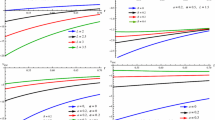Abstract
In this paper, the orbital dynamics of the gravitational field in Bardeen space-time are investigated. The equations of the particle’s orbital motion are given by solving the Lagrangian equation, and the stability and types of orbits are studied by means of analysing the effective potential of particles. Also, with the help of phase-plane method, the closed and non-closed orbits of test particle are analysed. We find that the stability and types of orbits in the Bardeen space-time are determined not only by the particles’ energy but also by the angular momentum. And for q=0.5M and b<3.3731M, absorbed by the black hole is the only fate of the test particle. We also find that the position of the innermost stable circular orbit of Bardeen black hole occurs at r min =5.5722M.



Similar content being viewed by others
References
Ayón-Beato, E., García, A.: Phys. Rev. Lett. 80, 5056 (1998)
Ayón-Beato, E., García, A.: Gen. Relativ. Gravit. 31, 629 (1999a)
Ayón-Beato, E., García, A.: Phys. Lett. B 464, 25 (1999b)
Ayón-Beato, E., García, A.: Phys. Lett. B 493, 149 (2000)
Bardeen, J.: Presented at GR5, Tiflis, U.S.S.R., and published in the conference proceedings in the U.S.S.R. (1968)
Barrabés, C., Frolov, V.P.: Phys. Rev. D 53, 3215 (1996)
Borde, A.: Phys. Rev. D 50, 3392 (1994)
Borde, A.: Phys. Rev. D 55, 7615 (1997)
Bronnikov, K.A.: Phys. Rev. D 63, 044005 (2001)
Bronnikov, K.A., Dehnen, H., Melnikov, V.N.: Gen. Relativ. Gravit. 39, 7 (2007)
Cabo, A., Ayón-Beato, E.: Int. J. Mod. Phys. A 14, 2013 (1999)
Chen, J.H., Wang, Y.J.: Acta Phys. Sin. 50, 1833 (2001)
Cruz, N., Olivares, M., Villanueva, J.R.: Class. Quantum Gravity 22, 1167 (2005)
D’Afonseca, L.A., Letelier, P.S., Oliverira, S.R.: Class. Quantum Gravity 22, 3803 (2005)
Dymnikova, I.: Gen. Relativ. Gravit. 24, 235 (1992)
Hawking, S.W., Penrose, R.: Proc. R. Soc. Lond. A 314, 529 (1970)
Hawking, S.W., Ellis, G.F.: The Large Scale Structure of Space-Time. Cambridge Univ. Press, Cambridge (1973)
Letelie, P.S.: Phys. Rev. D 60, 104042 (1999)
Ma, Z.G.: Acta Astrophys. Sin. 20, 1 (2000)
Magli, G.: Rep. Math. Phys. 44, 407 (1999)
Mars, M., Martín-Prats, M.M., Senovilla, J.M.M.: Class. Quantum Gravity 13, L51 (1996)
Penrose, R.: Phys. Rev. Lett. 14, 57 (1965)
Podolsky, J.: Gen. Relativ. Gravit. 31, 1703 (1999)
Shen, W.D., Zhu, S.T.: Acta Phys. Sin. 40, 2032 (1991)
Stuchlik, Z., Calvani, M.: Gen. Relativ. Gravit. 23, 507 (1991)
Zeng, Y., Lü, J.L., Wang, Y.J.: Chin. Phys. Lett. 23(6), 1648 (2006)
Zhou, S., Chen, J., Wang, Y.: Int. J. Mod. Phys. D 21(09), 1250077 (2012)
Acknowledgements
This work was supported in part by the Talent Cultivation Foundation of Kunming University of Science and Technology under Grant No. KKSY201207053. Yu Zhang would like to acknowledge the support of the working Funds of the Introduced High-level Talents of Yunnan Province from the Department of Human Resources and Social Security of Yunnan Province.
Author information
Authors and Affiliations
Corresponding author
Rights and permissions
About this article
Cite this article
Zhang, Y., Li, E. & Geng, J. Orbital dynamics of the gravitational field in Bardeen space-time. Astrophys Space Sci 351, 665–669 (2014). https://doi.org/10.1007/s10509-014-1866-2
Received:
Accepted:
Published:
Issue Date:
DOI: https://doi.org/10.1007/s10509-014-1866-2




